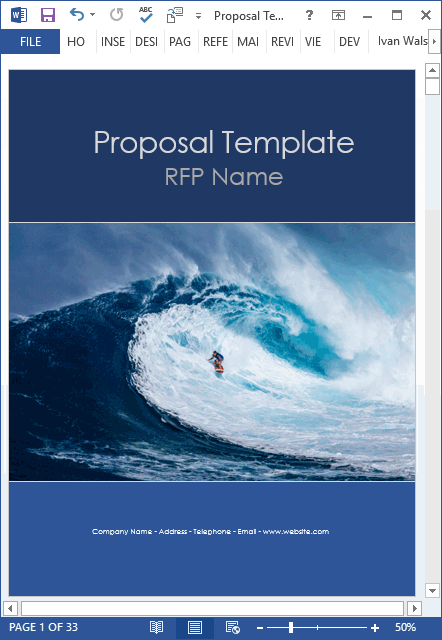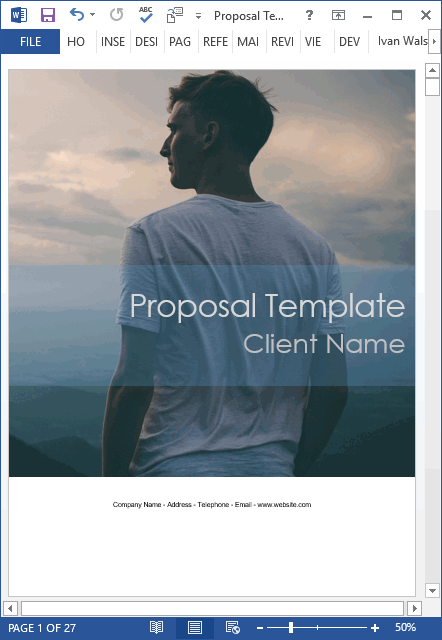Proposal Writing Tips
3 Storytelling Techniques for Business Proposal Writers
Seen The King’s Speech?
Business writers can learn a lot from it. For starters, imagine how hard it must have been to get funding.
‘Well, it’s about this guy who stammers a lot. Or stutter. Whichever’s the right word…’
‘He stammers?’
‘Yeah, all the time.’
‘It’s a great story. Let me tell you what happens when he meets his teacher. You won’t believe it. This guy’s the King of England…’
If you’ve seen the movie, you know what comes next. It’s a wonderful story.
Actually, it’s more than that. Avatar, Mission Impossible, and others blockbusters will look dated in ten years but you’ll still enjoy this. Why not? It’s a great story.
So, what’s this got to do with proposal writing?

Work Breakdown Structure template with sample data
[ Learn more about these Proposal Templates ]
Make proposal writing more about *you*
In a former lifetime, I reviewed proposals for government agencies. We’d get bids from all the big names. Super-sided proposals bursting at the edges with appendices.
It was a well-paid gig. And rightly so! From 9-5.30 we’d huddle in a room reading through page after page of utter dross and clap-trap.
It was hard to believe the procession of cliches, jargon, TLAs, and ‘copy and pasted’ boilerplate text that past before our eyes.
With a few exceptions, most were terrible.
‘Are they even trying?’, I began to wonder.
The answer is, Yes! Of course, they were. And very hard I’m sure.
No doubt the proposals had been through multiple revisions, edits, and last minute tweaks.
So, why were they so awful?
Because they copied the same formula that other proposal writers used. There’s nothing wrong with that… if it works.
But does it?
This striking image can be used in a variety of RFP responses, from technical, government, to fund raising.
[ Learn more about this Proposal Template ]
How to weave narratives into your proposals
Let’s go back to reviewing business proposals for a moment. When we reviewed the documents, we faced a few challenges:
- Remove deadwood. Those who failed to answer all mandatory requirements were disqualified.
- Create a shortlist. Based on value for money, experience, and proposal solution we prepared a shortlist. We disqualified the rest and concentrated on four or five.
- Score the bids. Using weights, formulas, and calculations we’d award points based on different criteria. It’s an inexact science and we often didn’t agree on the weights.
- Assess the results. Cross-checking to make sure we’d made the correct calculations.
- Award. Submit our recommendation to the project sponsors.
Here’s the thing. Somewhere along the way, we’d begin to get a feel for who’d win. This was usually early in the review process.
‘What do you think of their bid?’
‘Something about this doesn’t feel right, does it?’
‘Not sure I’d want to work with this lot. Can’t see the rest of the crew wanting to either.’
‘Sounds like another bid to me. Just churning them out. Look at the intro. Cut and paste job!’
You get the idea. For different reasons, we’d take a shine to some bids and give others the cold shoulder.
Why? We, the proposal reviewers never had (or would) meet most bidders. But some proposals were more engaging than others.
Rather than feeling punished for having to read them, we looked forward to the clear, crisp writing and… the stories they wove into the narrative.
3 ways to add stories into your business proposal
What seemed to make a difference was three things:
- Stories – In the solution section, they’d include ‘case studies’ that showed how other companies used their solution. But they made one subtle change. The quotes came from ‘real people’ on the floor, not generic statements from the CEOs. Their grammar may not have been perfect, but it felt better. It made an impression.
- Questions – Most proposals answer questions. That’s the default response. But, by posing questions back to the RFP team, you demonstrate that you’ve thought about the solution on a much deeper level than most other bidders. It forces the RFP team to consider points they may have over-looked. It makes them curious about you. You start to stand out.
- Pen Portraits – Instead of including dry CVs, some bids included short (100 word) profiles of the bid team. Some included head-shots. A nice touch. It brought the proposal to life.
Conclusion
Don’t confuse professional writing with boring writing.
You can write exciting, witty, engaging prose and still be professional.
Actually, if you think about it, boring documents shouldn’t qualify as professional in the first place, should they?
If we’re both in agreement with this, then how do we make our business documents more interesting?
This is one of the most popular templates, especially for business consultancy proposals
[ Learn more about these Proposal Templates ]
Editor’s Note: This post was originally published in April 2011 and has been updated for freshness, quality, and comprehensiveness.


